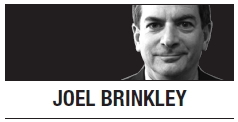LUANG PRABANG, Laos ― Travel through Southeast Asia, and wherever you go you’ll find statues of Buddha ― meditating, cogitating, calling for peace or for rain. The multiple poses are varied, and each one has its own meaning.
But only one pose shows the Buddha actually grinning. That’s the Buddha who is fat, sitting in a chair, his belly so big it looks like he’ll be unable to stand up.

This might seem odd, given that Buddhism is generally an ascetic faith. To reach enlightenment, you’re supposed to temper your craving for wealth and physical things. Be satisfied with who you are and what you have.
But then, Buddhists, like everyone, must eat. And in this part of the world, that’s a constant challenge for most people. So the fat Buddha is smiling because he has reached the state where he no longer has to worry about getting enough to eat. He’s finally content ― and oh-so happy.
Vietnam, according to Central Intelligence Agency figures, has a lower obesity rate than any nation on earth. Just above Vietnam at the bottom of the list is Laos. And that’s not because Vietnamese and Laotians are devotees of Weight Watchers diet plans. No, too many of these people generally cannot get enough to eat.
Some Vietnamese like to say they envy fat people. And here in Laos, I watched a middle-aged Laotian man affectionately pat the belly of an overweight American tourist and smile, his voice laced with envy, as he bowed his head and said: “Good, Good!”
The CIA was able to get obesity figures for fewer than half the world’s nations. Otherwise, Cambodia and Myanmar would certainly be near the bottom, too. While Myanmar is changing, slowly, it, like these other states, has been governed by uncaring, obdurate leaders for ages.
Five years ago, the United Nations’ World Food Program conducted a comprehensive study of Laotian children and found that half of them were severely malnourished in the first years of life ― setting them up for physical and mental stunting, which of course means they will grow up short and not terribly smart.
Well, here we are five years later, and UNICEF puts Laos’s stunting rate at 48 percent. No change. In Cambodia, it’s 40 percent, Vietnam 31 percent and 35 percent in Burma. By comparison, in Mexico, hardly a wealthy state, the figure is 16 percent.
Laos calls itself a Communist society, which means it’s supposed to bring workers into the larger economy. But the government totally ignores most of its people and provides almost nothing for them. Aid agencies here say their projects are “program based,” meaning that the program will die if the aid agency stops what it’s doing. The government just doesn’t care.
The most glaring example today: Laos is building a hydroelectric dam on the Mekong River, bringing howls of complaint from countries downstream, including Cambodia and Vietnam. You might think the needs of the Laotian people outweigh the complaints from the south. After all, only a handful of states, most of them in sub-Saharan Africa, provide less electric power to its populous than Laos. This country’s total, on average: only 39 watts per person each year.
Laotian officials, explaining the dam project at the groundbreaking ceremony late last year, told journalists they wanted to vault their nation from its status as one of the world’s poorest. But since then, the government has instead made a contract with its neighbor, Thailand. The Thai will buy most, if not all, of the power that the new dam generates.
So the dam will almost certainly benefit the Lao people not at all. The money earned from the Thai will go where most money here goes ― into the pockets of the Lao leaders. Laos ranks 160th out of 174 nations in Transparency International’s 2012 corruption index.
As a result, “there’s been a shift among donors; they’re moving away from supporting dam projects” here, Karen Stewart, U.S. ambassador to Laos, told me.
Around the world, religion is often a refuge, a salve for the poor. And many of the Buddhist nations are extremely poor. Buddha’s Four Noble Truths tell his followers they can reach Nirvana by abandoning sensual cravings and self-indulgence ― attaining dispassion toward physical things.
But when Buddhist pagodas all over this region so proudly display ancient images of the Buddha, their role model, when he is most joyful ― displaying the broadest imaginable grin because he’s obese ― you know that, through the ages, the people’s greatest concern has been getting enough to eat.
By Joel Brinkley
Joel Brinkley, a professor of journalism at Stanford University, is a Pulitzer Prize-winning former foreign correspondent for the New York Times. ― Ed.
(Tribune Media Services)








